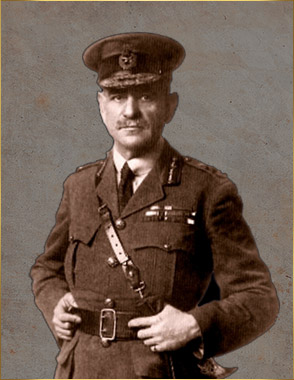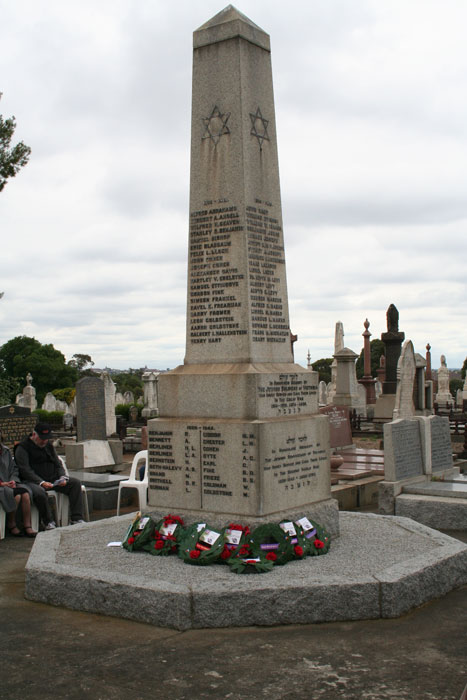Victorian Association of Jewish Ex & Servicemen & Women Australia Incorporated
Founding Member General Sir John Monash GCMG KCB VD
Benjamin
Surname
Benjamin
First names
Stanley Octavius
Rank
Bombadier
Service No.
3959
Date of Death
23/11/1916
Hebrew Date
27 Cheshvan 5677
Hebrew Date
כ״ז בְּחֶשְׁוָן תרע״ז
Age at Death
36
How Died
Died of Wounds
Where Died
Montauban, France
Cemetery
Dantzig Alley British Cemetery, Mametz, France
Service Details
1st Divisional Ammunition Column, Australian Field Artillery, AIF
Served
Gallipoli, Western Front
Occupation
Agent
Age at Enlistment
34
Place of Enlistment
Sydney, NSW
Locality on Enlistment
'Bolingbroke', Albion Street, Waverley, NSW
Religion
Jewish
Gender
Male
Date of Enlistment
15/1/1915
Date of Discharge
Country of Enlistment
Australia
Notes
Stanley Benjamin was born on 15 July 1880 Reg No 17240 in South Melbourne, Victoria. His was the son of Sir Benjamin BENJAMIN & Lady Fanny née COHEN. He was educated at Scotch college where he won prizes in Classics and Mathematics, the Argus prize in English and honours in French, Greek and Latin. He was keen sportsman playing in the Firsts in cricket and football. At the time of his enlistment in 1915, Stanley was living in New South Wales and working in Sydney as an insurance clerk and actuary for AMP. Stanley enlisted on 15 February 1915 in Sydney and was assigned the regimental number 3959. He was described as 5’ 6½” tall with a dark complexion, dark hair and blue eyes. Stanley gave his religion as Jewish. Having served for over a year with the Field Artillery Militia unit at Albert Park, Stanley’s prior experience in the artillery saw him assigned to 4th Field Artillery Reinforcements as a Gunner and he was posted to the artillery camp at Marrickville, NSW. On 10 April 1915, just two months after enlisting, Stanley embarked on board the A8 HMTS “Argyllshire” bound for Egypt. After crossing the Indian Ocean and making its way up through the Red Sea, the “Argyllshire” docked in Alexandria on 26 May 1915. Stanley and his mates disembarked and were then shepherded on to the train that would take them to Corio and the Australian Imperial Force Camp at Mena in the shadow of the pyramids. Here they continued their training and worked on their fitness levels. At the beginning of November, Stanley was told to pack up his kit and board the train for Alexandria. On 14 November, he embarked on the “Themistocles” for Gallipoli. On 21 November he was transferred to 3rd Battery Field Artillery and immediately went into action. Stanley’s time at Gallipoli was to be mercifully short, the winter storms had set in and the situation at Gallipoli has become untenable. The day after Stanley arrived, Lord Kitchener ordered the evacuation of the Peninsular. The winter storms were punishing and on 27and 28 November, severe rain and thunderstorms turned into blizzards. More than 280 men died of exposure and 16,000 cases of frost bite and exposure were reported. Between 9 and 23 December, the withdrawal of the guns and the troops took place under the cover of darkness, miraculously without the loss of any lives. Stanley was evacuated on board the “Tunisian” and he arrived back in Alexandria on 3 January 1916. Back in Egypt, the whole AIF underwent a program of expansion and rebuilding. On 21 February 1916, Stanley was transferred to the 4th Divisional Artillery at Tel el Kebir and on 13 March he was posted to the 21st Howitzer Brigade. Five days later on 18 March, he was promoted to Bombardier. Just over a month later, Stanley and his unit were once again on the train to Alexandria. On 25 March, they boarded a ship bound for France and the Western Front. They disembarked at Marseilles on 1 April and again boarded a train heading north to Armentieres. Although the Armentieres area considered a “nursery” sector, the fighting had begun for the Australians. The artillery was deployed in support of not only the Australians but also British troops in the area. It was quiet but things were about to change. On 1 July, the battle of the Somme began with a massive artillery barrage that went on for days. It was supposed to destroy the German defences and demoralise the enemy. It didn’t work and the Battle of the Somme has now gone down in history as an incredible bloodbath that went on until 18 November when winter rain and icy conditions brought an end to the battle. Throughout the battle, Stanley and the unit had supported Australian and British troops. Although the battle was officially over, each side continued to shell each other’s positions. It was on 23 November 1916, during one of these tit for tat exchanges that Stanley was to lose his life. There is no official report on the circumstances of Stanley’s death but a report was published in the 1919 journal of this old school “The Scotch Collegian” that states the Stanley was drawing rations for his gun crew at the supply depot at Montauban, when an enemy shell exploded, the force of the explosion sent him flying some distance and that he was thought to have died instantly. The official records indicate that he died of wounds and was buried in the German cemetery at Montauban. After the war his body was exhumed and was reinterned in the Dantzig Alley British Cemetery (Plot IX, Row P, Grave No. 8), Mametz, France. For his service during the World War I, Stanley Benjamin was awarded the 1914-15 Star, the British War Medal and the Victory Medal.

 John Monash (Monasch) born
in Melbourne, Australia on 27 June 1865, the son of
German Polish Jewish migrants, can be researched in any
military history encyclopaedia or in fact by just
‘Googling’ his name on the internet. His history
and list of achievements are long and far too many to detail
in this brief summary. However, might I say that reading his
history is well worth the effort and I can assure you that
his deeds will amaze you. I have found that the deeds are
better labelled on more than one man and in more than one
lifetime.
John Monash (Monasch) born
in Melbourne, Australia on 27 June 1865, the son of
German Polish Jewish migrants, can be researched in any
military history encyclopaedia or in fact by just
‘Googling’ his name on the internet. His history
and list of achievements are long and far too many to detail
in this brief summary. However, might I say that reading his
history is well worth the effort and I can assure you that
his deeds will amaze you. I have found that the deeds are
better labelled on more than one man and in more than one
lifetime. An
announcement was made in the weeks leading up to the
Centenary of ANZAC by Judy Landau, President VAJEX Aust.
She stated that it gave her great delight to announce
that VAJEX Aust (Victorian Association of Jewish Ex
& Servicemen & Women Australia Inc) has
successfully raised the required funds to build a new
Victorian Jewish Memorial after the style of the
historic Memorial located in the Jewish section of the
Melbourne General Cemetery. After an extensive two year
process, Judy has single-handedly sought letters of
support, raised the funds, and obtained approval from
the City of Port Phillip.
An
announcement was made in the weeks leading up to the
Centenary of ANZAC by Judy Landau, President VAJEX Aust.
She stated that it gave her great delight to announce
that VAJEX Aust (Victorian Association of Jewish Ex
& Servicemen & Women Australia Inc) has
successfully raised the required funds to build a new
Victorian Jewish Memorial after the style of the
historic Memorial located in the Jewish section of the
Melbourne General Cemetery. After an extensive two year
process, Judy has single-handedly sought letters of
support, raised the funds, and obtained approval from
the City of Port Phillip.
